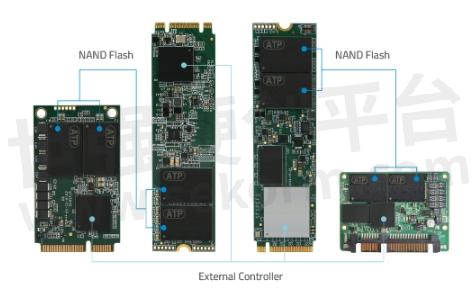Showdown Between Consumer & Industrial SSDs

Key Considerations in Choosing the Right Flash Storage
We live in an era where enormous amounts of data are being generated by the minute, and industries have to seriously consider the most optimal methods of accessing and processing data to meet escalating demands 24/7. While solid state drives and other forms of flash storage are increasingly becoming common choices for their performance and capacity, they are not all the same. Deciding based only on surface criteria may not be the best road to take, especially in industrial applications where data integrity, retention and availability are essential to undertaking critical tasks. How then should you choose the right storage?
As more and more SSDs are being deployed, industries are turning to client- or consumer-grade SSDs to achieve lower total cost of ownership (TCO). Look through the specifications, and at the outset, it may seem that industrial and Consumer SSDs are similar. How suitable are consumer SSDs for industrial use? Going past capacities and form factors, let us look closely and discover a world of difference.
Consumer SSDs are typically used in personal gadgets or for office use, such as on a desktop PC, laptops, handheld and mobile devices, cameras or gaming consoles. Purchases are driven by personal needs or preferences, and technical support is limited.
Industrial SSDs are found in high-performance applications where data integrity and reliability are of paramount importance, such as data centers, server farms, aerospace and avionics, military applications, machine automation, medical solutions, and in-vehicle computing.
Key Considerations
In industrial applications, devices are subjected to harsh environments, operate non-stop in a wide range of severe temperatures, handle enormous workloads, and constantly tackle threats that could compromise secure functionality. It is therefore important for storage devices to be extremely reliable, as device breakdown can lead to data loss and lengthy downtime with catastrophic consequences.
Optimized Performance and Low Latency. consumer flash products are designed for single or few users handling a certain amount of data usually for personal use. Industrial SSDs are engineered to process millions of bytes of data that may be simultaneously accessed by several clients. Latency, also known as response time or wait time, refers to the delay between the time an instruction is sent and the time it is actually executed. Industrial flash products deliver low latency for sustained performance and maximum productivity over long stretches of time.
Wide Temperature Range. While consumer flash products are rated at only 0℃ to 70℃, industrial grade products are built to withstand wide temperature ranges from -40℃ to 85℃, enabling them to operate reliably even in extremely cold or hot operating environments. ATP is among the early storage manufacturers to offer M.2 NVMe SSDs with industrial temperature ratings.
Drive Longevity. Industrial applications require heavy workloads that lead to higher program/erase (P/E) cycles that could impact the endurance of the storage drive. Endurance cycles on TLC-based consumer SSDs range around 1,000 P/E cycles while ATP's products have about 100,000. Higher P/E cycles mean industrial SSDs take longer to wear out. ATP's industrial flash products also feature advanced wear-leveling to extend SSD life, evenly distributing writing on all blocks to avoid writing too often on the same blocks and ensuring that they all wear out evenly. A high Terabytes Written (TBW) rating also reflects drive endurance. It shows how much data can be written to the drive during its entire usage life. The ATP Velocity SII Pro 2.5"SSD for example, has a very high TBW rating of up to 21,333 TB.
Rugged Durability. Mean time between failures (MTBF) refers to the average amount of time that a device functions before failing. For ATP's industrial SSDs, this can go from 2 million hours or 114 years to as high as 5 million hours, which translates to over 570 years. Moreover, ATP flash products are built with extra protection to guard against solid particles as well as liquid and gaseous corrosions that could damage components. System in Package (SiP) technology encapsulates all exposed components to provide protection and shielding, so ATP memory cards are waterproof, dustproof and shock/vibration proof.
Power Loss Protection. While consumer SSDs also offer some resistance to power interruptions, industrial SSDs take it to a whole different level, using techniques and circuitry to mitigate the risks of unexpected power failure. ATP's flash storage products feature advanced power failure protection, which prevents data loss during a power loss event. ATP PowerProtector ensures that the last read/write/erase command is completed and data is stored safely in non-volatile flash memory. ATP SSDs with PowerProtector use tantalum capacitors, which have minimal sensitivity to temperature and humidity, assuring high reliability and endurance even in harsh environments.
Flash Memory Categories
Selecting the right flash type for your application and workload is also very important to ensure that you derive the maximum benefits from your investment. There are two general categories of flash memory.
Raw NAND Flash Memory. This type of NAND flash requires an external hardware controller to handle the flash management functions, such as bad block management, wear leveling, error correction, logical-to-physical address translation, garbage collection, and other functions. ATP offers a full range of SSD modules with raw NAND flash memory in different form factors and capacities.

Figure 1. ATP SSD modules with raw NAND flash memory.
Managed NAND Flash Memory. This type of memory combines raw NAND and a sophisticated hardware controller within the same package, allowing memory management to be done internally. Because all components are integrated in one package, the internal controller handles all the NAND flash management, freeing the host from having to do wear leveling, bad block management, error correction, and other background functions. Managed NAND memory is designed to deliver fast performance while consuming lower power. Due to the integrated design, they are available in very small form factors. The most popular forms of managed NAND are flash memory cards.
The table below lists other examples of managed NAND flash memory.

Table 1. ATP managed NAND products.
The image below shows the differences in raw and fully managed NAND architectures. Raw NAND requires an external hardware controller to handle the flash management functions while fully managed NAND solutions feature an embedded controller within the package to handle wear leveling, bad block management, and error management.


Figure 2. Raw vs. Managed NAND
Flash Forward
Determining what kind of flash storage to use is a critical decision that could impact operations and return on investment (ROI). Storage designed for a single consumer will perform very differently from storage designed for rugged, demanding and mission-critical applications and thousands of users. What may seem less costly may actually be more expensive in the long run, so it is important to get the right SSDs that match your workload as well as your budget to get the most out your investment.
ATP's wide range of industrial SSDs is designed for long, reliable performance under heavy workloads and even in the harshest and most demanding environments. As a true manufacturer, ATP manages the stages of the manufacturing process and conducts thorough testing from wafer/IC level to module and product level to ensure that only products of the highest quality are produced from its facilities.
- +1 Like
- Add to Favorites
Recommend
- How Temperature Affects Data Retention for SSDs
- ATP Electronics Launches Industrial 176-Layer PCIe® Gen 4 x4 M.2, U.2 SSDs Offering Excellent R/W Performance, 7.68TB Capacity
- Predict Ssd Lifespan by Understanding Endurance Specification
- The ATP Gym and Coach System: Exercising SSDs to Ensure Total Fitness
- T5PFLC 2.5″ and M.2 2280 SATA Solid State Drives (SSDs) Come Equipped with FIPS 140-2 Encryption Capabilities
- 100,000 P/E Cycles Reached, Apacer’s 3D NAND SSDs Deliver the Highest Endurance Available
- Benefits of ATP‘s Dynamic Over-Provisioning for SSDs
- Mnemonic Electronic Debuts at COMPUTEX 2024, Embracing the Era of High-Capacity SSDs
This document is provided by Sekorm Platform for VIP exclusive service. The copyright is owned by Sekorm. Without authorization, any medias, websites or individual are not allowed to reprint. When authorizing the reprint, the link of www.sekorm.com must be indicated.



























































































































































































































































































































































































































































































































































































































































































































































































































































































